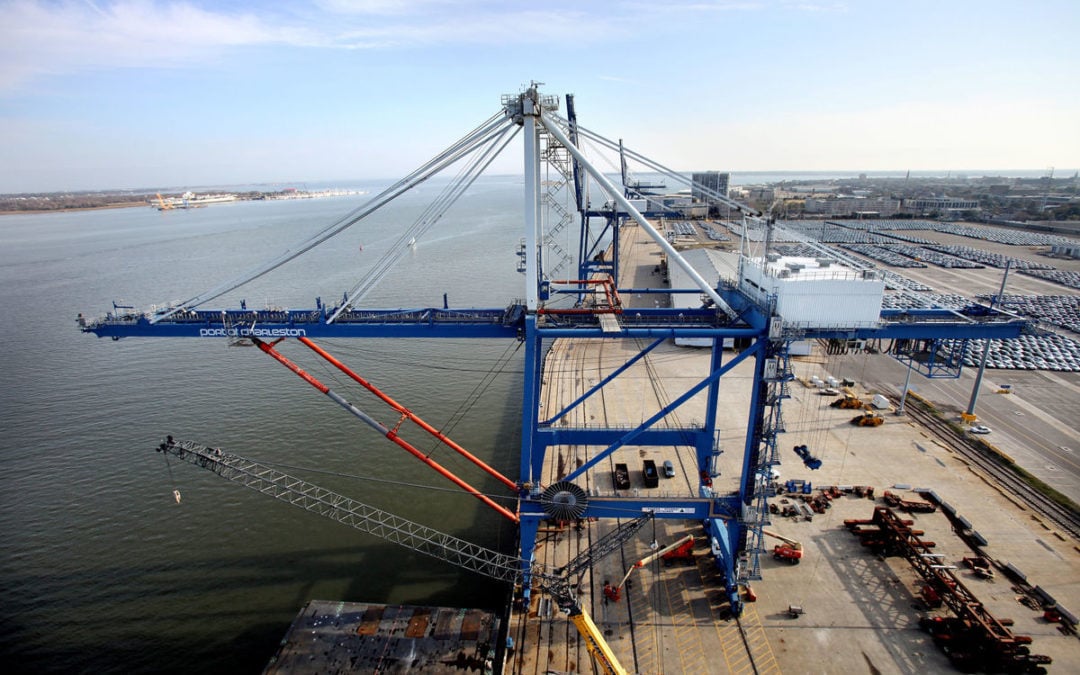Gone – possibly for good – are the last of the State Ports Authority’s towering blue-and-white container-ship cranes that, like spindly sentries, stood guard for decades along the harbor at the Columbus Street Terminal.
In recent years, though, the aging hoists were on the verge of obsolescence, outgunned by newer technology and outsized by the world’s growing fleet of mega-ships.
So off they went last weekend – by sea, naturally – to their next waterfront assignment.
Their unheralded departure affirms the latest role for the port’s 155-acre Columbus Street yard, which, history shows, has a knack for adapting to the times. Its versatility earned it the nickname of the “Variety Store,” according to a 1988 newspaper account.
The modern-day Columbus Street Terminal can be traced back to 1958, when state lawmakers allocated $21 million to beef up the then-tiny Charleston port. At the time, the SPA operated just one cargo berth – at Union Pier. The two-year expansion farther up the peninsula’s east shore – described as a “tear down and rebuild” of the old Columbus Street Docks – would give it four more.
In those days, the waterfront was a bustling place of forklifts, boom hoists and strong backs. The loose heavy, cargo known as “breakbulk” had to be handled manually, for the most part. All kinds of commodities and other goods, from fruit to textiles to lumber, went back and forth across the docks.
The tide began to change March 12, 1966, when the pioneering Sea-Land line brought a container ship for the first time to Columbus Street. With the help of an on-board crane, the crew working the Gateway City that day loaded and off-loaded several dozen steel cargo boxes weighing up to 40,000 pounds each. A company official estimated it would have taken up to a week to complete the same job the old way.
The container era was officially on in Charleston.
Over time, the SPA invested in the specialized landside cranes it needed to transfer the boxes from ship to shore and vice versa, acquiring its first in the early 1970s. It also continued to expand the wharf and improve rail access at Columbus Street.
The beginning of the end came in the early 1980s, when the Wando Welch Terminal in Mount Pleasant opened. It would go on to replace Columbus Street as the port’s workhorse container yard.
The last crane lift on the peninsula property was five years ago.
Since then, Columbus Street has returned to its roots. Once again, it’s a busy breakbulk cargo hub.
“I think it’s serving the right purpose now,” SPA chief executive Jim Newsome said Thursday.
Gone are the days of banana and timber shipments. The downtown terminal in now a waterfront way station for sophisticated, high-ticket goods that can’t be shipped in boxes, such as the big turbines that GE makes in Greenville and the luxury automobiles BMW manufactures in Greer. Volvo, which is building a car plant in Berkeley County, also is expected to make use of the property once its new factory is up and running.
The final two cranes standing at Columbus Street were about 19 years old. They were too small to be of much use at the SPA’s other two container terminals or at the third it’s building on the old Navy base. The agency’s board struck a deal to sell them as a set in August for to DP World, a Dubai-based company that owns about 80 transportation hubs worldwide. They fetched $3.9 million.
“We looked at moving them to another terminal,” Newsome said. “That’s expensive, so it made sense to us to sell them. We had a willing buyer that had a compelling need, so we did.”
The cranes are bound for a slightly cooler home. DP World plans to use them at its St. John, New Brunswick terminal in Canada.
It’s hard to imagine container ships ever returning to Columbus Street, but Newsome wouldn’t rule that out. He can “see a scenario” where the “roll-on roll-off” automobile carriers that now tie up regularly at the terminal are equipped to stow boxes as well.
“I never says always, and I never say never,” Newsome said.




